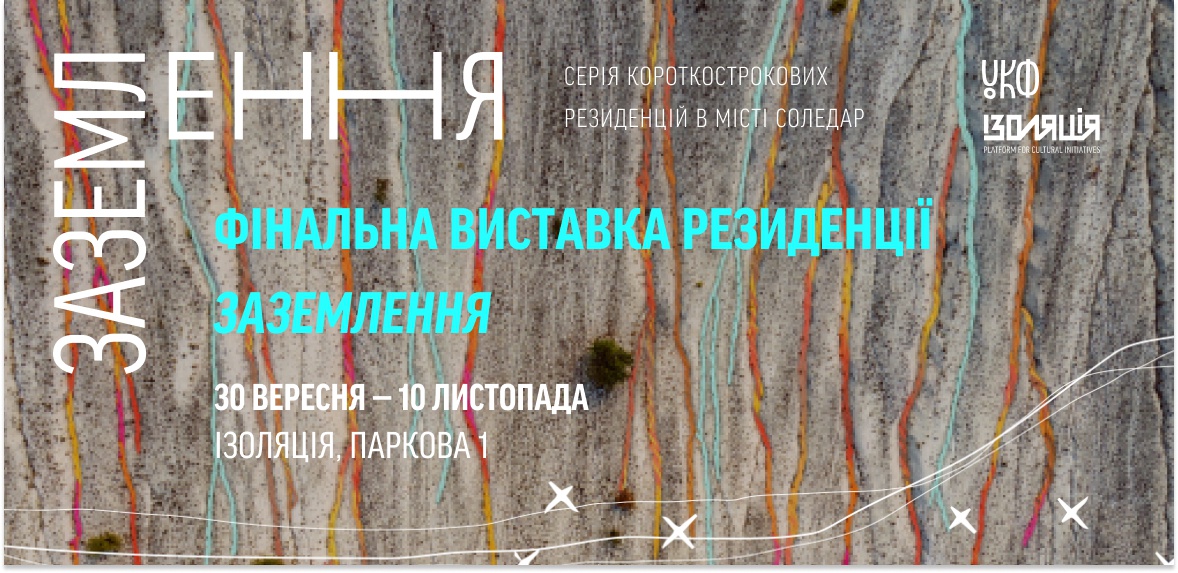Exhibition by participants in the Grounding residency series

On 2 December at 19:00 in IZONE, the opening of the final exhibition by participants of the Grounding residency series in Soledar will take place.
Over the course of nine months in 2021, the IZOLYATSIA Foundation, in collaboration with the Soledar Amalgamated Hromada and with the support of the Ukrainian Cultural Foundation, conducted the Grounding short-term residency series in the city of Soledar for artists and researchers working with the theme of the Anthropocene.
Since 2019 the IZOLYATSIA Foundation has been working on a research concept under the name Grounding, which takes the concept of the Anthropocene as its starting point. This idea was developed in the early 2000s by scientists and rather quickly appropriated by different areas in the humanities, including contemporary art. ‘Anthropocene’ describes the geological epoch which modern humanity finds itself in, and which it defines as the central geological force, fundamentally changing the planet’s atmosphere, hydrosphere and biosphere.
It was precisely the area’s industrial history, the landscapes changed by human activity and the natural diversity of the east of Ukraine that the 19 researchers, artists and art collectives which worked on their projects in Soledar addressed in their exploration of the area. Thanks to local people who willingly shared their knowledge of the city and its history, and joined in the activities offered by the residents, the residents created a series of art works in diverse media such as video, photography, sculpture, painting and installations. Some of the projects are in the post-production stage, and others are already completed. Astian Rey’s sculpture and Roksolana Dudka’s mural can be seen in the city’s public space on a permanent basis.
Photo documentation of the Grounding residency series will be displayed at the exhibition.
Residency participants: Open Place, Nazarii Zanoz, Valentina Bero, Zoya Laktyonova, Natalya Lyubchenkova, Vitalii Agapeev, Bohdana Voytenko, Natalia Mikhalchenko and Yulia Kirichenko, Evhen Korshunov, Svyatoslav Koverznev, ruins collective, Oleksii Radynskyi, shallow_wat and @some_static_pictures, Pavlo Kovach, Yarema Malashchuk and Roman Himey, Vira Shelest, Astian Rey, Roksolana Dudka.
Soledar
Soledar is a city in Eastern Ukraine, located at the confluence of the river Mokra Plotva with the Bakhmutka (a tributary of the Siverskyi Donets), in the north-eastern part of Donetsk Oblast. Today, it has a population of 11400 people. From 1924 the town was called Karlo-Libknekhtovsk. In 1965, it received city status. It received its current name of Soledar in 1991.
Among salt-bearing regions, a special place is occupied by the south-eastern part of the Donbas, where huge lodes of rock salt formed in the location of a shallow bay of the ancient Permian Sea around 295 million years ago. Due to movement and displacement of tectonic plates, the salt is hidden under the earth at depths from 120 to 320 metres. There are three main working salt beds from nine surveyed, on which salt mining has been taking place for more than 130 years.
The history of Soledar is closely connected with the development of Bakhmut salt mining. It is on record that in the late 16th and early 17th century chumaks came to the Torski (Slavyanski) Lakes for salt. In 1697 the operators of salt pans at Tora, which had been destroyed by the Tatars, began to resettle on the tributaries of the Bakhmutka. There were several settlements in the area where Soledar is now located, including Bryantsivka (earlier called Bilousivka), which appeared in the first half of the 19th century.
From 1876-1880 the geologist and future academic Aleksandr Karpinsky carried out geological research around Bryantsivka. He proved that deeper underneath the gypsum there should be deposits of rock salt. In 1879, mining engineer P. Ivanov drilled a bore hole between Bryantsivka and Oleksandrivka, which showed the existence of nine salt beds in the earth, including the highest-yield Bryantsivka bed, 40 metres in thickness.
Later in the 19th-20th c. after the discovery of the rock salt deposit, mines and plants were built. In 1879 construction started on the first salt mine in the Donbas, ‘Bryantsevskaya Kop’, on the right bank of the river Mokra Plotva. Local inhabitants built 11 houses next to the mine and rented them to the workers. A small settlement arose. In 1889, the mine community numbered 530 people.
Just a few metres away from the Bryantsivka pit another one opened – the Dekonska mine. And so the ‘salt fever’ began, which, similar to the coal one, gripped entrepreneurs. New mines were established, as well as exploratory boreholes in the Ivanovska, Ilyinovska, Bakhmutska and Mykolaivska districts. And so, over the course of a few years, a whole slew of other salt mines were established: ‘Novaya Velichka’, ‘Kharlamovskii’, ‘Petr Velikii’, ‘Dekonskii-Pokrovskii’ (Sitenko Mine).
In total, eleven mines were established on the deposit in the pre-revolutionary period, three of which are still working today (No. 1, No. 7 and No. 8). In Soviet times, the new mine No. 4 was also opened. By 1914, they already numbered nine. And apart from this, not far from the village of Bryantsivka deposits of quartzite, gypsum (alabaster) and fire clay were discovered, and in 1899 the Limited Company of Dekonska Alabastar and Fireclay Products and Materials was founded.